Plants that look good dead, as well as evergreens, make sensational small urban spaces.

A U.K. garden designed by Piet Oudolf in winter (photo: Piet Oudolf; source: The New York Times)
Dear Avant Gardener, What should we plant in the boulevard in front of our house? – Bill, St. Paul, MN
Plants that look good dead, LOL! Actually, I’m not kidding. By this I mean what Piet Oudolf calls structure plants. These are late-season flowering perennials with interesting foliage and seed heads, plus warm-season grasses – the sort of natives that evolved in the prairie and in sunny open areas in your mostly forested mixed wood plains ecoregion. They hold up well – and hold each other up – for a long season, well into late fall.
A plant is only worth growing if it looks good when it is dead. – Piet Oudolf
A dense mix of such structure plants creates the “On the Wild Side” Yardenality™ most popular among my readers. With its matrix of warm-season grasses, it requires less maintenance and is more resilient than a more garden-y arrangement of flowering plants. In addition to tolerating poor soil, drought, and occasional trampling, the diversity of plants in a small area makes mini-prairies resilient, with the thriving plants filling in when others fail.
That patch of land between the sidewalk and the street is often called a hellstrip because of its hot, punishing growing conditions. Although it sounds Medieval, the term was actually coined in the 1990s by horticulturist and native plant advocate Lauren Springer Ogden. As Graham Laird Gardner writes in his recent book Tiny + Wild,
You will need to take into account limitations such as foot traffic, pets, poor soil, compaction, lack of irrigation, car pollution, road salt, and more. Provided you have a way to water a hell strip meadow during establishment, the poor quality of the soil and lack of irrigation make it an ideal location for many meadow and prairie plants. – Tiny + Wild
St. Paul, like many communities, has specific requirements for boulevards. Plants must be under 18 inches or 30 inches, depending on the location, and may not hang over the sidewalk, curb, or street. “Noxious weeds” – mostly invasives – are prohibited. And fertilizers, pesticides, and herbicides may not be used without written permission – but you weren’t going to use those anyway, were you?
Salt tolerance, in addition to height, toughness, and sun requirements, will guide your plant choices. Road salt used to de-ice streets splashes or is plowed onto hellstrips. In fact, an analysis in Nature Reviews determined that road salt is the largest source of soil salinization in the U.S. Road salt accounts for 44 percent of all U.S. salt consumption.
You might start with these native species that stay under two feet and are supposedly salt tolerant: flowering yarrow, fringed sage, purple prairie clover, and scarlet globemallow, as well as sideoats grama, little bluestem, and sand dropseed grasses. Unfortunately, there is scant research on plant salt tolerance; there will be an element of trial and error to your mix – as there is to all plantings.
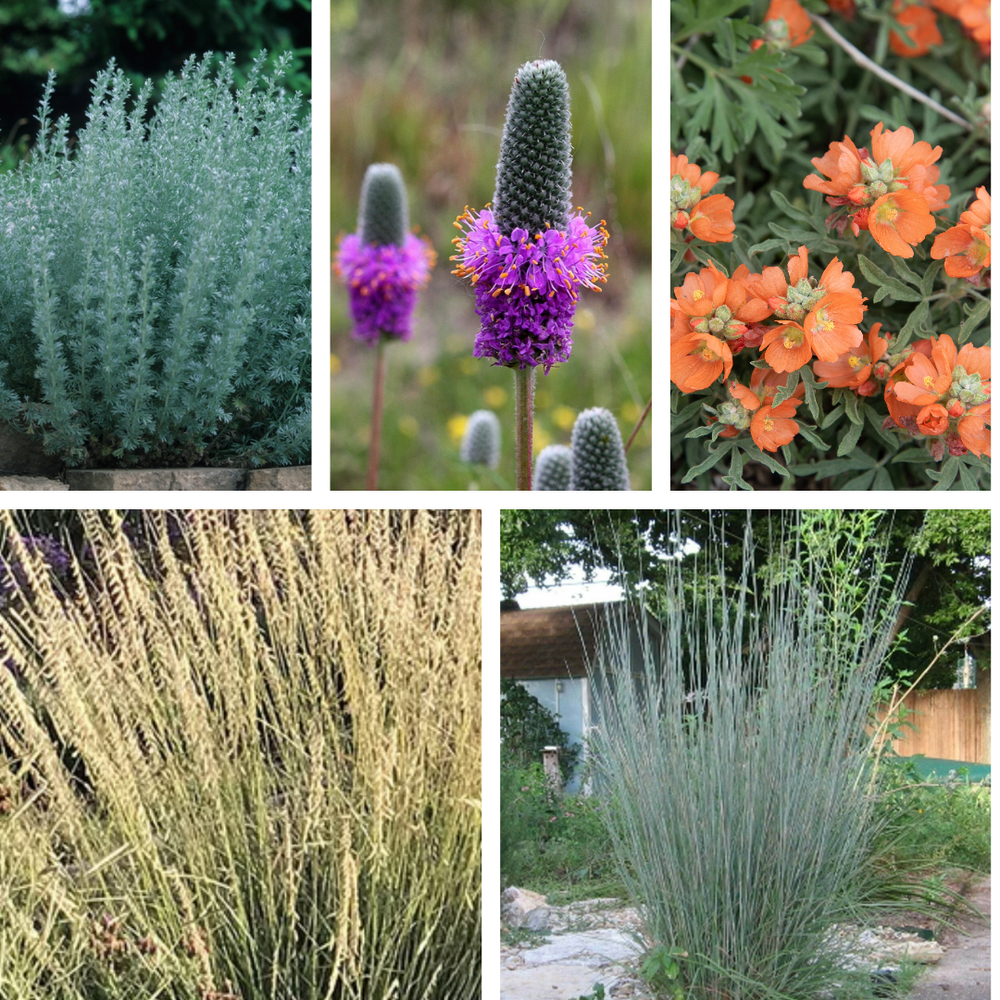
Salt-tolerant plants for a sunny Twin Cities boulevard, clockwise from top left: Fringed sage (Artemisia frigida), purple prairie clover (Dalea purpea), scarlet globemallow (Sphaeralcea coccinea), little bluestem (Schizachyrium scoparium), and sideoats grama (Bouteloua curtipendula)
These prairie plants are sun-loving. If your boulevard is shady, you’ll want to choose woodland plants. Woodland forbs tend to be smaller and more delicate, flowering early to make the most of the sun before trees leaf out. Native flowering woodland species reputed to be salt tolerant that stay under two feet include columbine, phlox, and calico aster. You can plant these into a heavy matrix of grassy fox and Gray’s sedges, also allegedly salt tolerant. The asters and sedges in this woodland mix will look good into November, when your St. Paul streets become covered in snow.
Most of these prairie and woodland plants are available from Out Back Natives in Hastings.
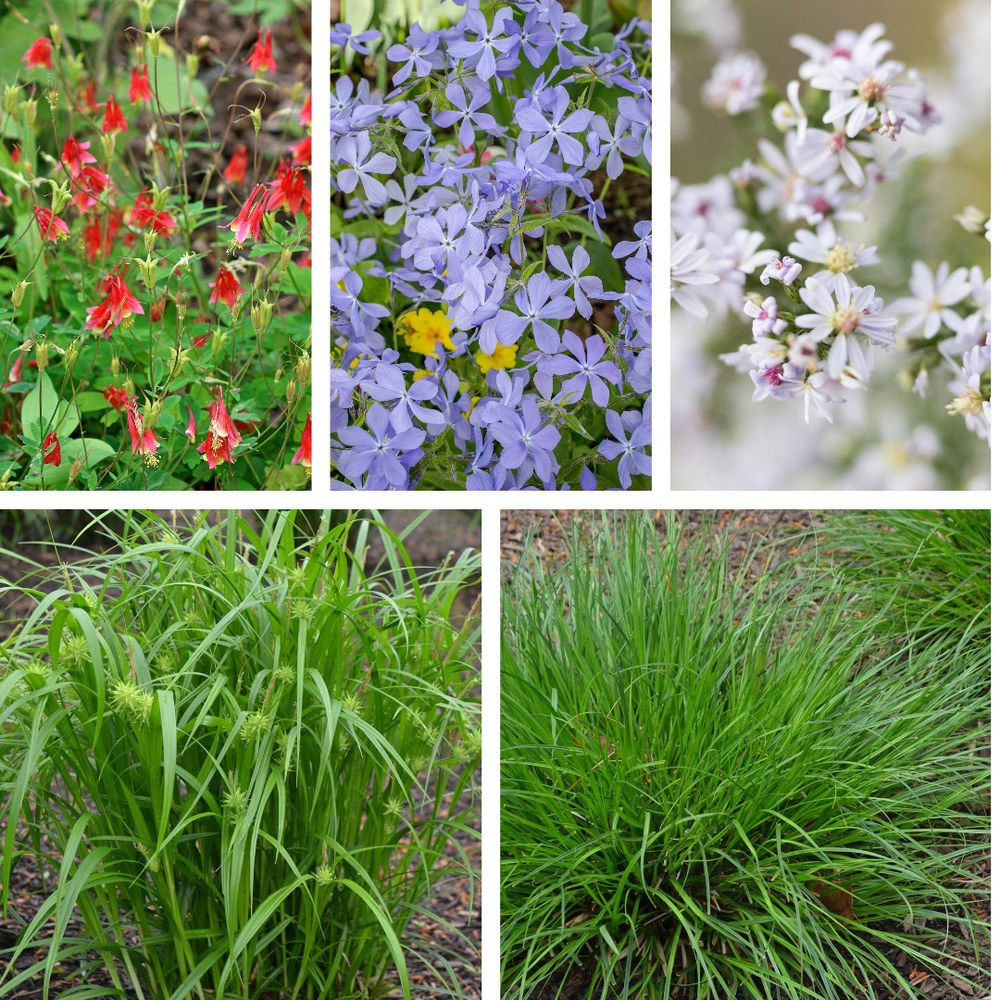
Salt-tolerant plants for a shady Twin Cities boulevard, clockwise from top left: Wild columbine (Aquilegia canadensis), blue phlox (Phlox divaricata), calico aster (Symphyotrichum lateriflorum), fox sedge (Carex vulpinoidea), and Gray's sedge (Carex grayii)
— The Avant Gardener
Dear Avant Gardener, My little deck garden is like a graveyard. It's hard to find proper plants that can survive the chilly crosswinds and cold temps. My jasmine, lavender, and fern all died. My bamboo is struggling. Lol at this point I will grow anything that might survive. I get afternoon sun. I would love, love to get a place and grow a big wildflower cottage garden. — CC, San Francisco
Frankly, I’m no expert on tending those dear departed exotics. (Quite the opposite: I proudly eliminated invasive bamboo from my Florida property!) But a quick look at your photo suggests the most important remedy: Bigger pots.
Tiny containers are unsuited to an exposed location. The larger the container, the better it retains water and insulates roots from cold.Start with pots at least 18 inches wide and deep. Big pots are expensive, especially good-looking ones, but even just one container of lush vegetation can have a big impact.
Still, plants are going to die – or at least, unless they are evergreen, go dormant. So, I recommend starting with dwarf native evergreens Manzanita ‘Big Sur’ and common juniper, which Suzanne Howard-Carter, owner of Oaktown Native Plant Nursery, recommends for your exposed location. The former blooms around New Year’s and can live many years in a container with raised (not in a dish) to allow air to circulate.
For the wild, flower-filled look you like, Howard-Carter recommends seaside daisy, coyote mint, and California fuchsia ‘Calistoga’ or ‘Everett’s Choice.’ These will attract bees, butterflies, and even hummingbirds to your balcony. The mint and fuschia have structure when dormant that you may learn to love.
If you make a four-season garden you have to learn to accept decay and see the beauty of it. It’s about the texture and shape, the seed heads and the skeletons. So instead of using the scissors you use your eyes. – Piet Oudolf in The New York Times
Alternatively, if looking through dead plants at your view for several months each year makes you sad, by all means, cut them back! In either case, do limit the number of containers to what you can comfortably maintain. Keeping a container garden looking good is work. The secret to always-great-looking containers? Often, paid landscapers swapping out plants before they fade.
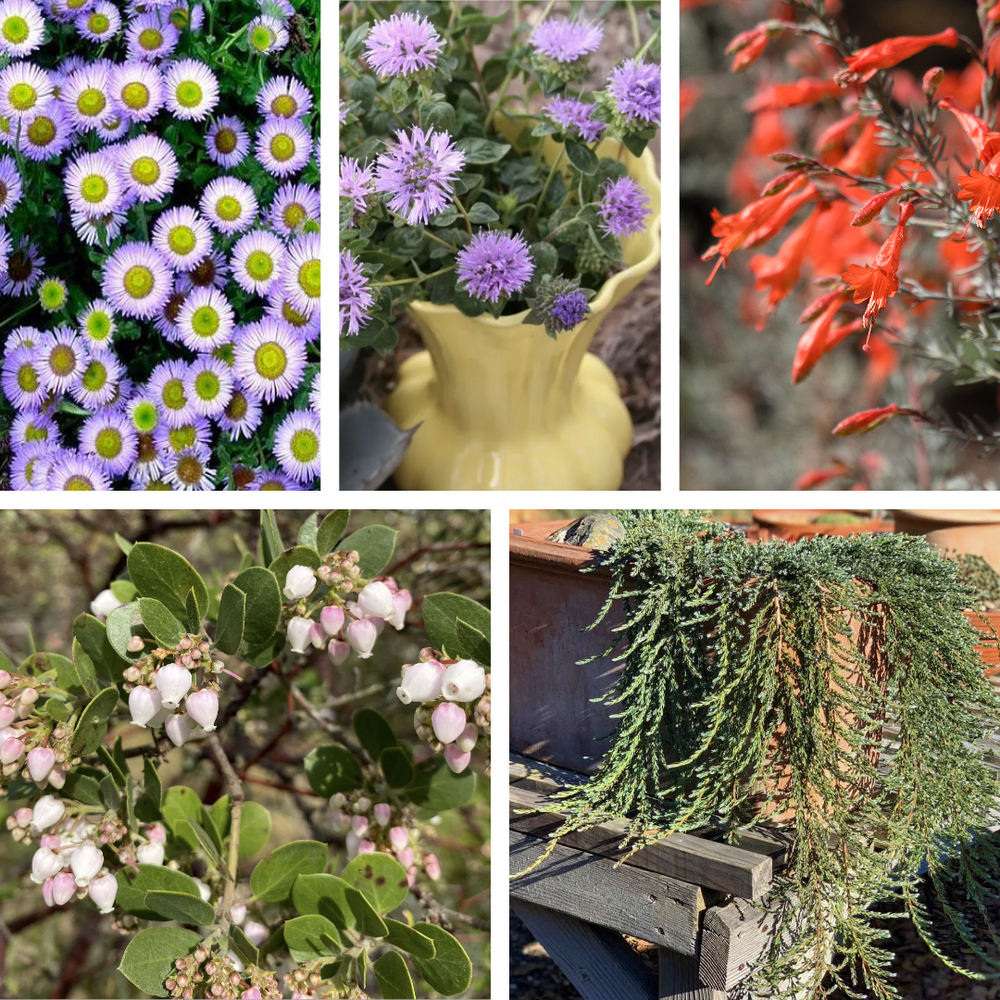
Tough plants for a windy San Francisco balcony, clockwise from top left: Seaside daisy (Erigeron glaucus), coyote mint (Monardella villosa), California fuchsia (Epilobium cana 'Calistoga' or 'Everett's Choice'), common juniper (Juniperus communis), and dwarf manzanita (Arctostaphylos edmundsii 'Big Sur')
– The Avant Gardener
Why, How, Wow!
Why?
An acquaintance recently asked me if it’s worth transforming her small, urban retaining wall garden with native plants. Absolutely! For wildlife, yes, but even more for yourself – for the joy of regularly experiencing a landscape alive with bees, birds, butterflies, and more.
Studies confirm wildlife manage to find small patches of greenery in urban contexts and restoring native vegetation increases biodiversity. And biodiversity increases well-being. According to a 2018 meta-analysis,
There is evidence for positive associations between species diversity and well-being (psychological and physical) and between ecosystem diversity and immune system regulation. – British Medical Bulletin
More recently, a study published this year found a direct, positive relationship between bird biodiversity – especially perceived biodiversity – and emotional response. The more bird species in a park, the happier the visitors felt.
This research utilised a mobile phone App, employed to assess people’s emotions when they entered any one of 945 green spaces within the city of Sheffield, UK. … Results demonstrated strong correlations between levels of avian biodiversity within a green space and human emotional response to that space. – Urban Ecosystems
How
You can create a mini-prairie by planting – or seeding – directly into turf grass, with or without killing it first by solarizing or smothering. The key is lots and lots of plants – about one per square foot. Thanks to Oudolf and other European naturalistic designers, deep-rooted plugs of native perennials and grasses are more available in the U.S.; they are less expensive than larger plants. (Seeding is less expensive, but requires more patience – and is not practical for a very small space where they might get washed away by rain and snow.)
Although you can find many plants online, the advice you’ll get, as well as the quality of the plants, will be better from a good native plant nursery in your area. So be ready to make a day trip of plant shopping. It’s fun. Really.
Did you notice I’m sending both this week’s readers to nurseries outside the big cities where they live? where you’d think they could find anything? Great native plant nurseries are few and far between and general nurseries usually have little choice and even less expertise in native plants.
Search Google maps for “native plant nursery in ___” and evaluate the quantity and quality of their reviews and their sites, notably their missions and inventory. This has worked better for me in various areas around the country than looking at lists from Audubon, etc.
When I spoke with owner Suzanne Howard-Carter of Oaktown Native, she balked at recommending a plant without knowing the specific location because San Francisco neighborhoods have distinct microclimates. That’s the kind of expertise you want.
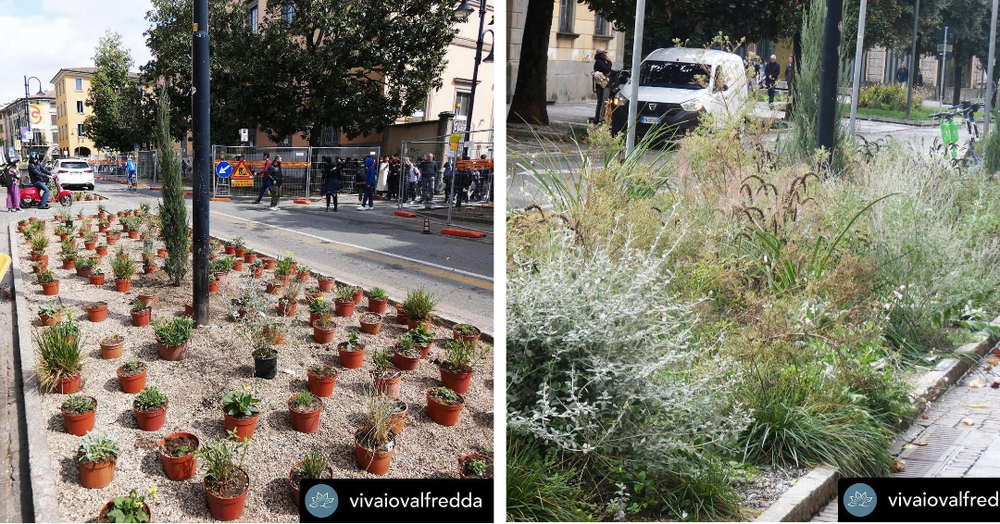
Hellstrip in Bergamo, Italy, by U.K. naturalistic garden design superstar Nigel Dunnett: Left, plants arranged for installation this spring; right, flourishing in November
Wow!
The density and informality of naturalistic design add a layer of resiliency to a high traffic area. – Tiny + Wild
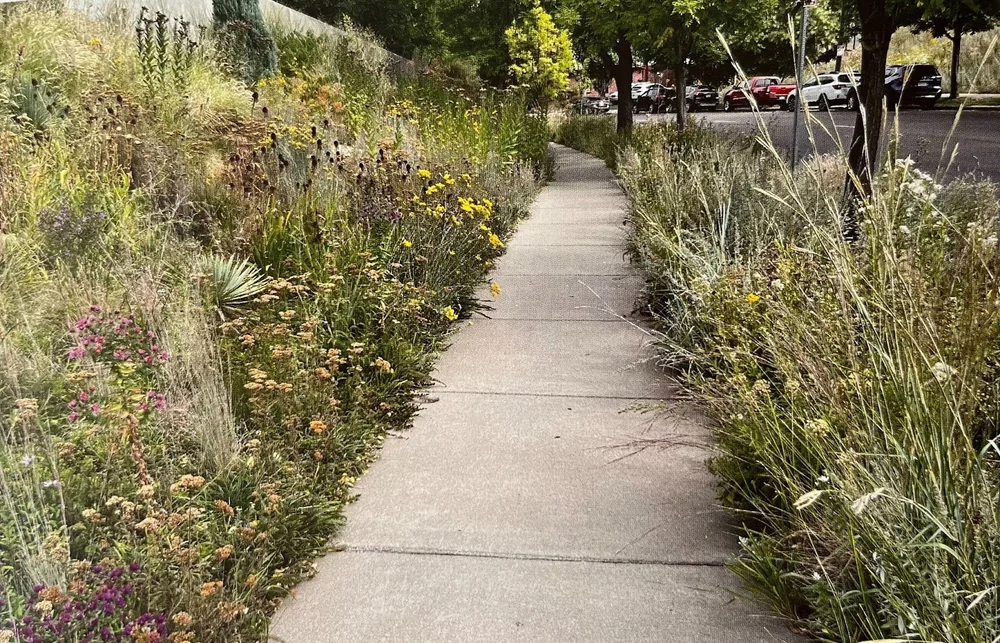
Photo: Graham Laird Gardner
Related Resources
Yearn for colorful container plantings like you see in London? Read Why I Resent English Gardening.
Want to grow plants from seed to install in the spring? Follow the instructions in Save Money with Winter Sowing.
Have a larger area you’d like to make a meadow? Learn how you can direct seed now in 3 Steps to Make a Meadow.